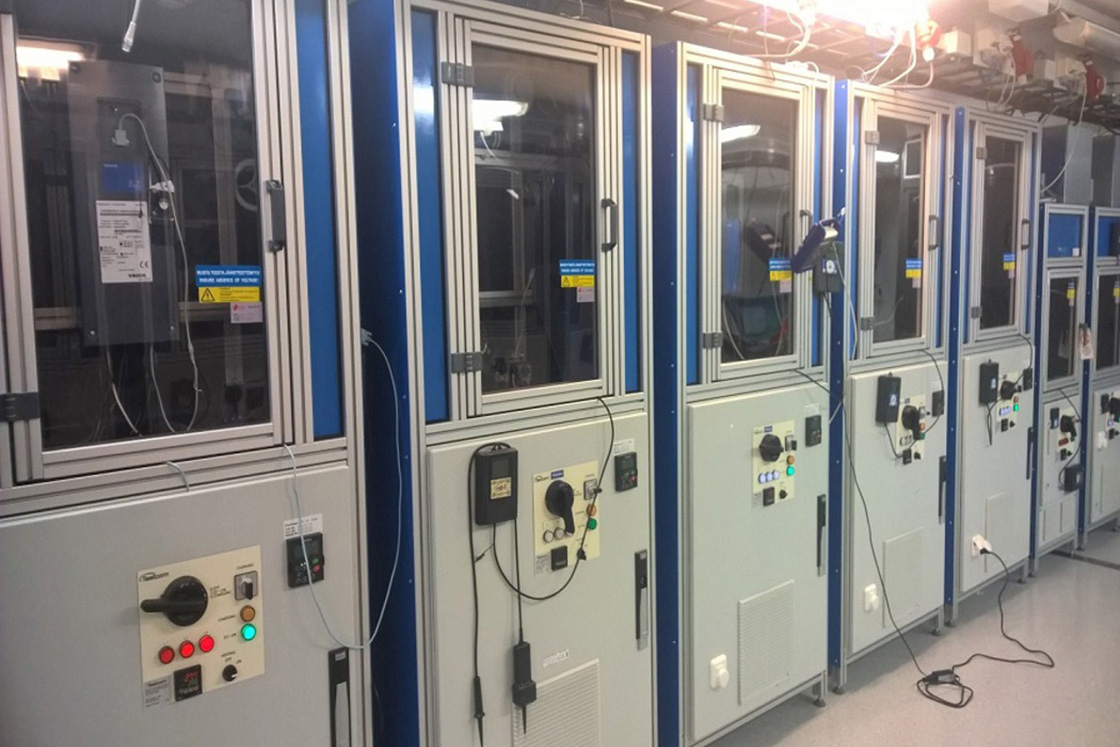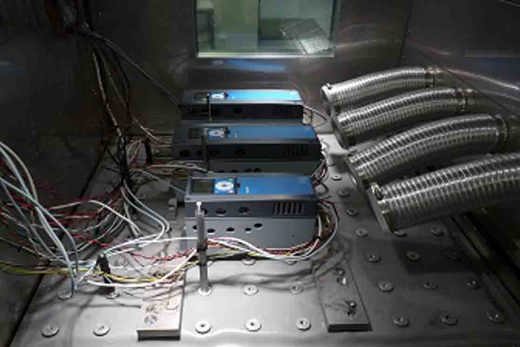
Product testing in varying environments is one of the most important types of research a company can conduct. Only by thoroughly analyzing the performance of a product and its components can we be sure that it will work reliably for a stated period of time, function according to its specifications under given environmental and operational conditions, and fulfill any statutory or regulatory requirements.
In reliability testing the effect of the environment on a product or component is studied, taking into account its whole lifetime. This testing is vital both in the development of existing and new products.
There are several levels and testing philosophies that must be taken into consideration when the overall testing plan is created:
- Component-level testing (to measure the performance and failure rate of components)
- Subsystem-level testing (to identify how failure mechanisms can affect each other)
- System-level testing (to gather important information on interactions)
- Qualitative testing (to compare tests between components, materials or different structures)
- Quantitative testing (to analyze the statistical reliability of the product or component)
Danfoss Drives has invested heavily in its testing facilities and currently carries out a wide range of engineering and testing procedures in its Design Centers in Finland and Italy. As a result of these investments, Danfoss Drives makes sure that the high quality and reliability of our products is maintained and will become better. This continuous testing work has shown its effectiveness in the past and will even improve in the future.
In reliability testing, our five main testing categories are:
- Highly accelerated limit testing (HALT)
- Accelerated life testing (ALT)
- Multiple environment over stress testing (MEOST)
- Endurance testing
- Temperature and humidity testing
Highly accelerated limit testing (HALT)
The procedures for testing are designed to establish the robustness of the product and obtain large margins over the expected use conditions. Testing determines the limits of the design and identifies the weakest links. Testing is performed at the subsystem level.
Accelerated life testing (ALT)
The procedures for testing are designed to determine the behavior of materials or components in different environments. They use an acceleration factor or the physics of failure model to estimate how and when failures occur in normal and elevated usage. Several factors can be used to elevate stress, such as temperature, humidity, power cycles or voltage transients.
Multiple environment over stress testing (MEOST)
The procedures for testing use a combination of accelerated environments and are used to cause failures and to reveal the weakest links in the design. Several factors can be used to increase stress levels, such as vibration, shock, power or temperature cycling and voltage variations. Testing is done at the component, subsystem or system level.

Endurance, temperature and humidity testing
The procedures simulate harsh field conditions and include static and cyclic testing. The aim is to find early failures from products prior to product launch, to decrease failures occurring throughout the product’s lifetime, and to reveal possibilities for decreased product lifetime due to early wear-out failures.
Temperature and humidity are environments that are always present, so it is highly important to have sufficient testing procedures in place. Moisture is a common cause of failure in electronics and that is why humid environments can also be simulated in our testing facilities. Most of the reliability tests carried out are stressed with either temperature, humidity or a combination of the two.
As you will have seen in our series of ‘Drives vs Harsh Environments’ posts, different environments affect the degradation of electronics. In our reliability testing laboratory, it is possible to study the effects of such environments on our products and minimize their impact throughout the product's lifetime. This is the key to our reliable and robust products.

Testing facilities
Several chambers are available in the Design Center to thoroughly test the reliability of small AC drives to large cabinets in a wide range of circumstances. All chambers are equipped with a 230-690V power supply and an artificial network up to 32A. Eight chambers are available for accelerated temperature testing where temperatures range from -40°C to +300°C (-40°F to 572°F) in different chambers. Two chambers provide temperature and humidity stresses from -70°C to +180°C (-94°F to +356°F) and 10-95% RH. One chamber creates temperature and vibration stresses from -100°C to +200°C (-148°F to +392°F) and 0-50 Grms. Additionally, a walk-in chamber is available to test larger products. This new equipment provides 30 m3 (1060 ft3) space to test products between -40°C and +100°C (-40°F to +212°F), and 10-97% RH. 37 heat chambers are available for endurance testing purposes, with controlled temperatures up to 60°C (140°F) and a transformer concept used for loading.
Failure analysis supports testing
A support function of testing is failure analysis. The Design Center in Finland includes a Material Analysis Laboratory that conducts material and component properties and quality analysis.
This highly equipped laboratory includes microscopes, cross-sectioning equipment, roughness meters, a coordinate measuring machine, an air quality meter, temperature, humidity, pressure and 3-axis shock recorders and an X-ray fluorescence analyzer.
The ultimate goal of testing and analysis is to eliminate reliability risks and make sure that our customers’ needs are met and our legal requirements are fulfilled throughout the lifetime of the product. Keep following this blog for more posts related to our various testing procedures and how they make our products better.
Author: Kati Kokko, Manager, Reliability Engineering and Test Design Center Finland and Italy, Danfoss Drives
